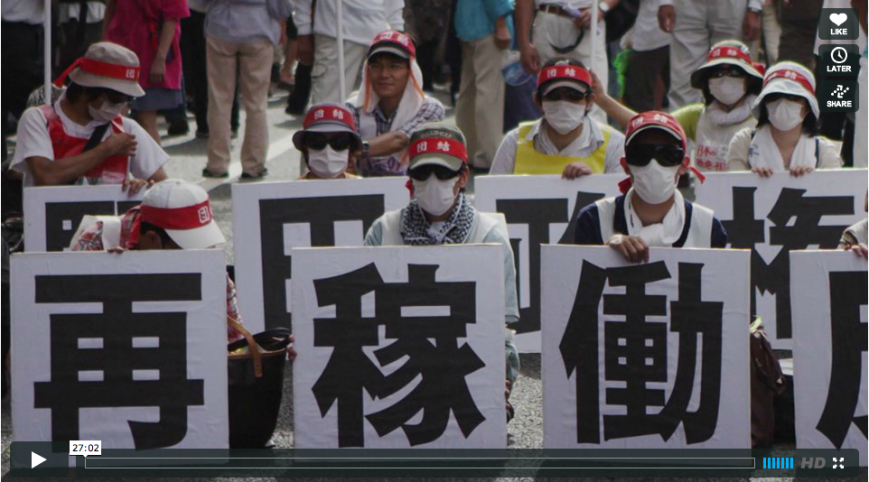English: Anti-Nuclear Power Plant Rally on 19 September 2011 at Meiji Shrine Outer Garden 日本語: 2011年9月19日に明治神宮外苑で行われたさようなら原発集会 (Photo credit: Wikipedia)
by Chihiro Kobayashi
When I was in the U.S., I joined some social movements such as “Stop Modern Slavery Walk” and “9.11 Unity Walk” for the first time. My image toward the U.S. is that they insist and try to change their society by themselves through social movements if the current society is not what they want. Therefore, when they want to change the society, social movements are one of the most important ways.
However, in Japan, many people would think social movements are a bad thing and they avoid doing it. One of the biggest reasons why Japanese people do not join social movement is that they fear the bizarre eyes toward people those who join movements such as demonstration march. I do not say there is no social movements at all in Japan, but I think the understanding toward social movements is lower than other countries. Since demonstration type of social movement is hated by Japanese, it is important to find the suitable social movement instead to change our society better.
At the Japanese Political Culture Theory class, I learned Japanese people tend to avoid joining social movements as their culture. Instead, they tend to rely on others to change the society. For example, in the case of politics, many Japanese people complain current policies and criticize about the government as well. However, Japanese citizens tend not to make social movements to change these, instead they depend on politicians to change these problems. I do not really know if these tendency is because of Japanese culture as I learned in the Political Theory class, but I think it is sure that many Japanese have negative image toward social movements. However, I think Japanese people need to have better understanding toward social movements because it is difficult to make our society only by depending on the politicians.
In the past seven years, the Prime Minister of Japan has changed seven times, and Japanese citizens do not expect politicians to make our society better anymore. Since Japanese cannot rely on and trust politicians anymore, how we can change our society? I think we individuals need to join social movements and speak out about the problems to the government.
For example, more and more anti-nuclear plants demonstrations have been occurring in Japan recently, since the Fukushima Nuclear disaster. However, Japanese still might avoid joining a social movement, such as a demonstration march, because they do not want to be seen as bizarre in the eyes of other people. I think there are many other ways which is more suitable for Japanese cultural characteristic to join social movements which is other than demonstration. For example, in the case of anti-nuclear power plants, we have these variety of social movements.
- Voting for anti-nuclear politicians: Social Democratic Party and Communist party are anti-nuclear plants.
- Purchasing campaign: By buying the products from local area, they can appeal that they do no need to depend on money from the nuclear power plants but they can be independent.
- Consumer Boycott: Avoid buying the products which company is related to building nuclear power plants, such as Toshiba, Mitsubishi Heavy Industries, and Hitachi, Ltd.
- Changing the deposit account: Our deposit which is deposited in mega bank such as Japan Post Bank and Bank of the post office is used in bond purchases, and as a result, it will be used to construct dam construction and nuclear power plant constriction. By changing the bank account such as to National Association of Labor banks, it is possible to prevent our deposit from being used for building nuclear power plant. (Stop Kaminoseki Nuclear Power Plant)
Even though these social movements do not stand out openly rather it is more hidden movement different from demonstration march in the city, these movements still have big power to change the society. Also, even if we cannot change our society and policies, we can still influence public policy by bringing attention to the issues. Considering the recent lack of trust in politicians, we individuals need to stand up to make our society better.
I think it is important for Japanese people to find the best suitable social movements for them, based on their political culture (avoiding demonstrations) because we have different culture and characteristics from Americans and other countries. These little by little hidden social movements might change not only policies but also might change people’s negative perspective toward the social movements in the future.
Reference
“Stop Kaminoseki Nuclear Power Plant.” Web. 19 Dec. 2013.
Related articles
- Japanese volcanologists say several nuclear power plants at risk if major eruptions happen (japandailypress.com)
- ‘Fukushima Fish Ends In Garbage’: Radioactive Fears Blight Japan’s Seafood Industry (infiniteunknown.net)
- Japanese volcanologists say several nuclear power plants at risk if major eruptions happen (outrageousminds.wordpress.com)
- ‘Fukushima fish ends in garbage’: Radioactive fears blight Japan’s seafood industry (rt.com)
- Fukushima Daiichi Nuclear Power Plant Disaster (japanesesearch.com)
- Nuclear power plant:electricity problem. (tsutomuwrites.wordpress.com)





